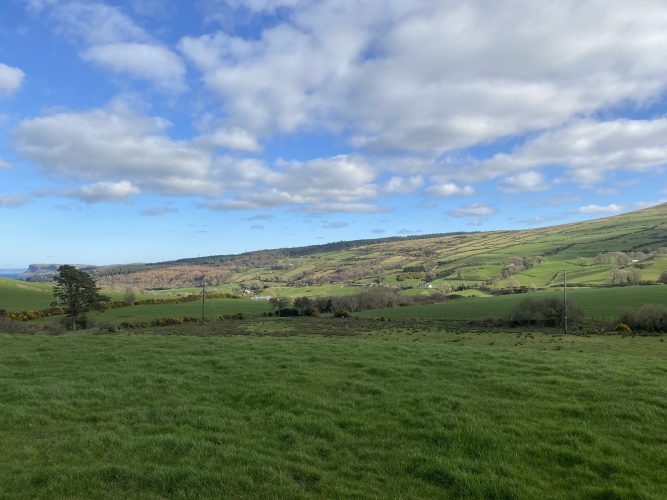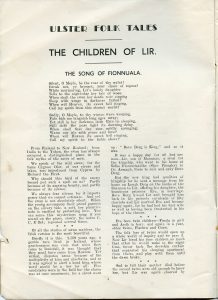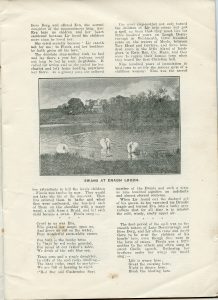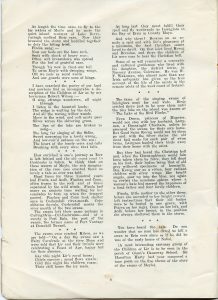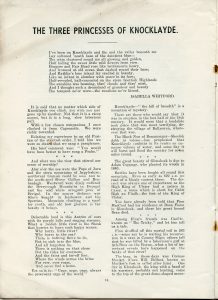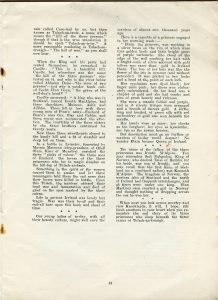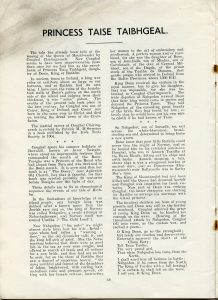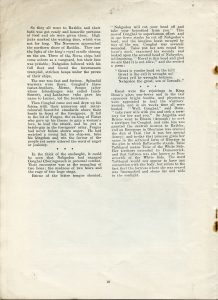11. Glentaisie

10. The Giant’s Sconce
6th March 2023
12. Gortnamoyagh Inauguration Stone
7th March 202311. Glentaisie
Glentaisie, the northernmost of the nine Glens of Antrim, is named after the legendary figure of Princess Taisie, who was gifted the lands and the Dun of Taisie at Broomore as a wedding gift from her father, King Dorm/Donn of Rathlin.
During her wedding celebrations to Conghal, heir to the kingdom of Ireland, King Nabgodon of Norway arrived to claim her for his bride.
Having heard reports of the beauty of Taisie he was eager to make her his queen. In the great battle which ensued King Nabgodon was killed.
Glentaisie- Named for a Princess
By Rebekah Stewart
Glentaisie is the northernmost of the nine Glens of Antrim, situated below Knocklayde and including the townland of Ballycastle. It is named after the legendary figure of Princess Taisie, who was gifted the lands and the Dun of Taisie at Broomore as a wedding gift from her father, King Dorm/Dunn of Rathlin.
The name of ‘Glentaisie’ comes from the Irish Gleinn Taoibhgeal, meaning ‘Glen of the bright cheeks’. Taisie was allegedly described as “a damsel of imperious beauty (…) bright eyed, with curling hair, melodious voice and pleasant speech. A perfect woman and of royal blood”.
As local legend goes, during her wedding celebrations to Conghal, heir to the Kingdom of Ireland, King Nabgodon of Norway arrived to claim her as his own bride. He had heard reports of the beauty of Taisie and after losing his own wife, was eager to make her his Queen. A great battle was fought, and King Nabgodon was killed, his army returning back without their leader.

The Taise Banner
Remnants of Taisie’s legacy remain in the form of a banner which can still be seen in the seasonal museum of Ballycastle. It was one of nine banners designed by local artist John Campbell (Seaghan MacCathmhaoil) to be carried at the first Glens Feis (Feis na nGLeann) in 1904. This banner painted by William McMullan of Culfeightrin depicting the Princess Taisie is thought to be the only remaining of the original nine banners. The glens and Dun are named after her, and local artist ‘Friz’ has dedicated a mural on Glentaise Drive to an image of the Princess relaxing as she was spotted by King Nabgodon’s men.
The Children of Lir
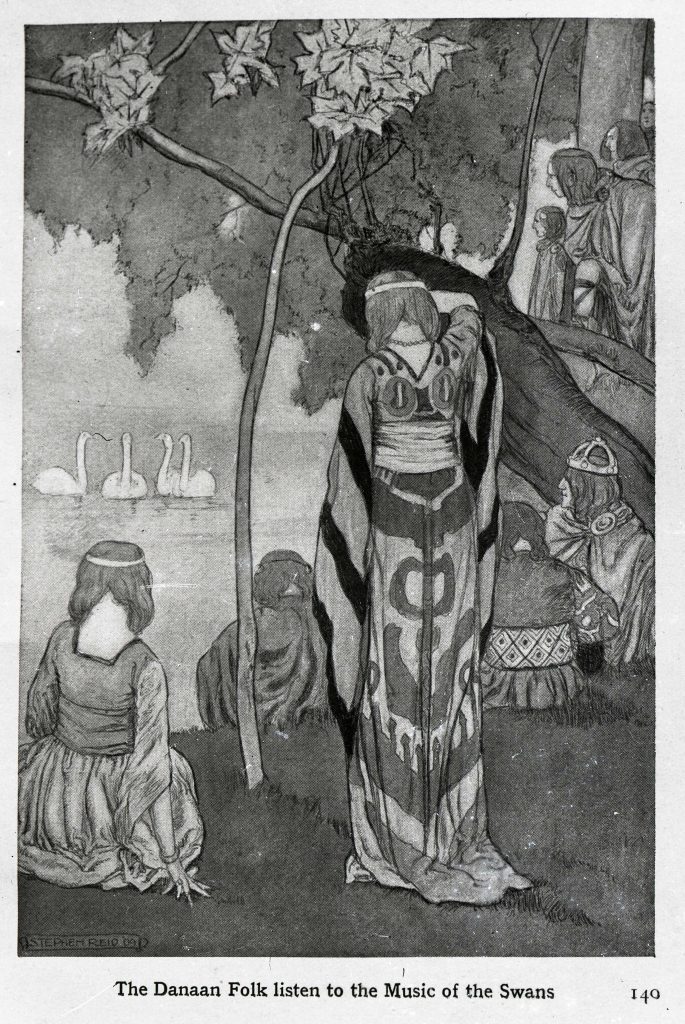
Sketch of the Children of Lir. Courtesy of the Sam Henry Collection.
Another royal connection to the area of Glentaisie is the tragic story of the Children of Lir. Lir married Aoibh, the daughter of the ruler of Ireland (Bodh Derg), as part of an alliance in which he gave up his right to rule. Lir and Aoibh had four children – one girl, Fionnghuala, and three sons, Aodh and twins, Fiachra and Conn. They were very happy until Aoibh tragically died after giving birth to the twins. Lir was distraught but sought comfort in the children.
Bodh eventually sent another of his daughters, Aoife, to marry Lir. Aoife saw how much love Lir had for her stepchildren and grew jealous, plotting to kill them. She took them on a coach ride and tried to convince her assistants to kill them, but they refused. She eventually persuaded them to bathe in Loch Dairbhreach and turned them into swans, cursing them to spend 300 years there, then 300 years in the straits of Moyle above Ballycastle and 300 years at Erris in County Mayo. They pleaded with her but the only kindness she allowed them was to maintain their human voices – Aoibh was often heard singing to comfort her brothers. Lir realised something was wrong and when he eventually found the children as swans singing their sad story, he was distraught. A law was passed then that no swan in Ireland was to be killed or hurt.
- The Children of Lir from Sam Henry’s ‘Ulster Folk Tales’.
- The Children of Lir from Sam Henry’s ‘Ulster Folk Tales’.
- The Children of Lir from Sam Henry’s ‘Ulster Folk Tales’
Eventually, the swans heard the bells of St. Patrick and the saint allowed them to be taken to the monastery, freeing them from the lakes. Lairgnen, the King of Connacht, sent for the swans as a gift for his wife. The monk Mochaomhóg refused to give the children up, and on Lairgnen’s touch as he grabbed them, the feathers fell off and revealed an old woman and three old men. Fionnghuala asked the monk to baptise them and bury them, sensing they were close to death. The tale is a fine example of post-Christian Irish mythology, where the pagan elements of metamorphosis and curses are balanced by the blessings of the Saints and the Christian God. Today, you can see a statue of the Children of Lir as swans at Ballycastle seafront.
There is another story in Ulster Folk Tales which tells the tale of The Three Princesses of Knocklayde:-
- The Three Princesses of Knocklayde from Sam Henry’s Ulster Folk Tales.
- The Three Princesses of Knocklayde from Sam Henry’s Ulster Folk Tales.
The historical Battle of Glentaisie between the two powerful Gaelic dynasties of the O’Neills and the MacDonnells is also named for the area. This battle, fought around the modern area of Ballycastle, marked the end of James MacDonnell’s rule in Antrim and set up the infamous Sorley Boy, his younger brother, as the last remaining MacDonnell. Although Sorley Boy could not claim control of the area until the Battle of Orra in 1583 due to the success of Shane O’Neill at the Battle of Glentaisie and Sorley’s capture, the Battle of Glentaisie undoubtedly set him up as the future leader of the MacDonnell Clan.
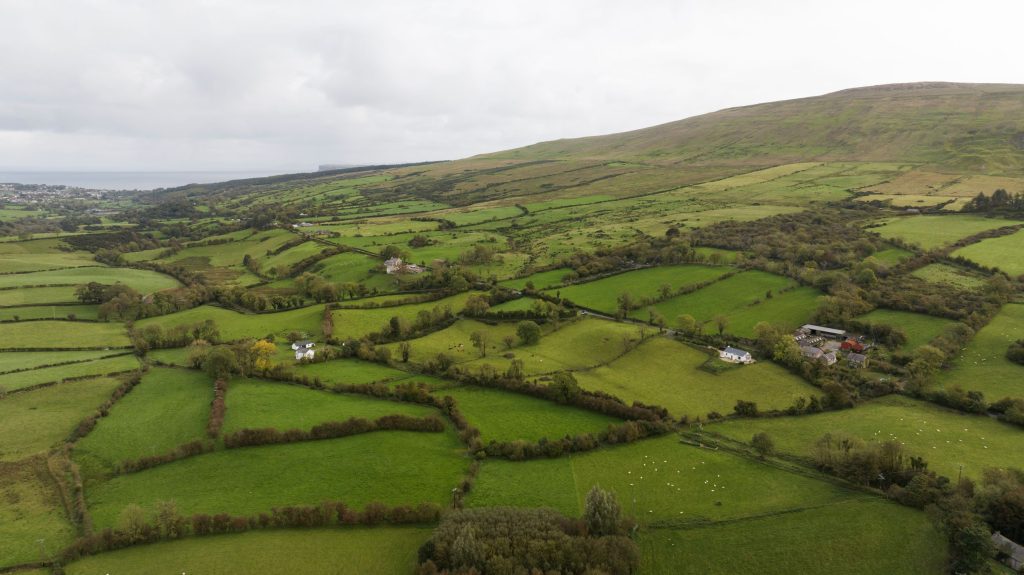
Glentaisie looking towards Ballycastle.
References
Friz on Facebook, ‘Ballycastle, NI’, (https://www.facebook.com/thisisfriz/posts/princess-taiseballycastle-niprincess-taise-taisie-was-the-daughter-of-king-donn-/344628587060888/) (accessed 21/11/2022).
Glens of Antrim Historical Society, ‘Glentaisie’, (https://antrimhistory.net/clachan-project/glentaisie/) (accessed 21/11/2022).
Naturally North Coast and Glens, ‘The Princess Taisie Project’, (https://www.naturallynorthcoastandglens.co.uk/post/princess-taisie-project) (accessed 21/11/2022).
Wikipedia, Battle of Glentaisie, (https://en.wikipedia.org/wiki/Battle_of_Glentaisie) (accessed 22/11/2022).
Wikipedia, Children of Lir, (https://en.wikipedia.org/wiki/Children_of_Lir#cite_note-7) (accessed 22/11/2022).
Directions
Co-ordinates: 55.1832, -6.2745
This project is receiving financial support via the District Council Good Relations Programme.

- Princess Taise Taibhgeal from Sam Henry’s ‘Ulster Folk Tales’.
- Princess Taise Taibhgeal from Sam Henry’s ‘Ulster Folk Tales’.
- Princess Taise Taibhgeal from Sam Henry’s ‘Ulster Folk Tales’.

